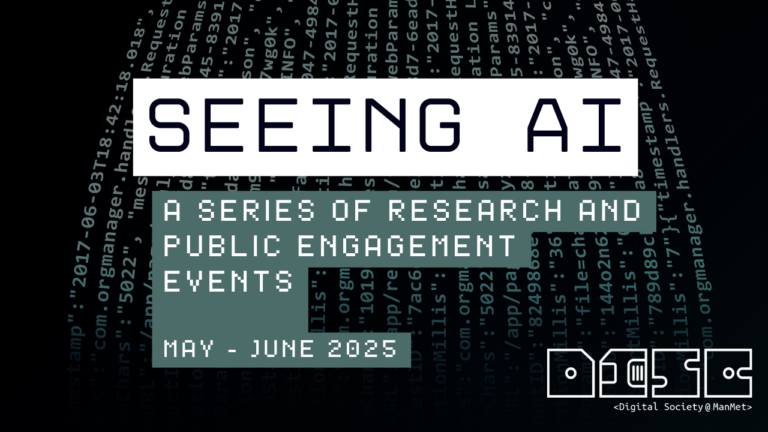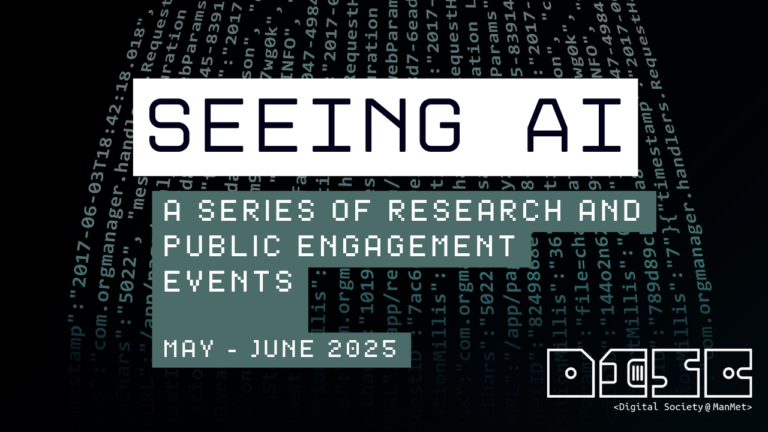Visual generative AI –a major threat to truth? And what researchers and policy makers can do about it

In our AI Literacy working group, we are exploring the impact of AI on all aspects of social and political life. Among these, we address the role of visual generative AI and its impact on international politics. This post was written by Dr Adi Kuntsman, the co-lead of DISC and AI Literacy group, and originally published by Metropolis – MMU’s own think tank that brings together researchers and policy makers.
In 2023, visual generative AI has taken up the global community of social media users by surprise, when an AI generated image of Pope Francis wearing a Balenciaga puffer jacket has gone viral, and was mistakenly believed to be real by many users. Social media erupted in laughter and heated debates about whether the image was real or not; whereas media pundits have flooded the internet with discussions about the image, ideas about the future of fashion and, more importantly, the future of misinformation. Fashion worries aside, the concerns raised by the virality and the highly realistic nature of this image are far more serious, as evidenced by many other AI-generated deepfakes of politicians and political events, such as a fake video of the Ukrainian President Volodymir Zelensky ordering his troops to surrender, or the many AI generated images of dead or injured civilians from Gaza and Israel, which were circulated in abundance alongside the authentic ones.
Deepfakes – highly realistic digital photos or videos of real people depicting a false situation or action, usually with a malicious intent, such as pornography or disinformation – are not new, nor are they unique to generative AI. However, the rapid rise and popularisation of generative AI tools and apps, allowing creation of fake images with a high degree of realism quickly and effortlessly, is a very new phenomenon, one that evolves faster than we can catch our breath, and one that we as a global society are still grappling with. While tech companies and the market excitedly advocate for more and more apps and tools to “unleash creativity”, “create breathtaking images” using “state of the art techniques” and “discover a stream of visual possibilities”, academics in the fields of journalism, media, and misinformation are more sceptical. Many raise serious concerns about a new era of misinformation: the AI technology brings a scalar shift in both volume and speed of image generation, and the visual aspect makes those images particularly effective from the emotional point of view. Other scholars warn about the erosion of trust in social institutions, the media, and the first-hand citizens witnessing: if any realistically-appearing image on social media can be fake, what is there to believe?
What can researchers do?
Researches across disciplines in humanities, social sciences and the arts have a major role to play, and the “AI Literacy” working group at MMU is taking the lead. The group is part of the Digital Society (DISC) research group which I co-lead with Dr Daniel Joseph, where we look at social aspects of digital technologies and their use. Much can be learned about visual generative AI from looking at the biases involved in the process of creating AI-generated images, as was recently shown to us by Dr Nataliia Laba, visiting DISC from Netherlands. Similarly, much can be learned from the research on social media audiences, who take part in dissemination and consumption of AI-generated “fakes”- this is the focus of my own work in progress. Most importantly, researchers should take a leading role in developing AI literacies – and visual AI literacy is a crucial one among them!
What should policy makers do?
The UK Government has recently announced a crackdown on sexually explicit deepfakes – a much welcome initiative, but one that focuses narrowly on just one type of deepfakes and the harms they can inflict. The field of AI-driven misinformation is far more broader and more amorphous. Policy researchers are putting all efforts into addressing the need for governance of generative AI – again, a crucial turn in policy scholarship, but one that tends to leave visual generative AI behind. I believe that developing visual AI literacy is a crucial start. At present, most misinformation literacy initiatives stop at “fact checking”, but neglect to develop broader literacy skills to understand the production, dissemination, and consumption of potentially fake – or, as they are now called, “synthetic” – images. Given that every new phone has at least a few gen AI apps embedded and given the insistent push by the tech industry to offer even more, this is a societal task of primary importance.



